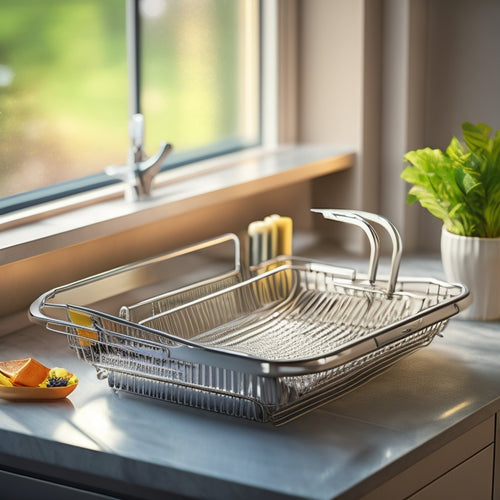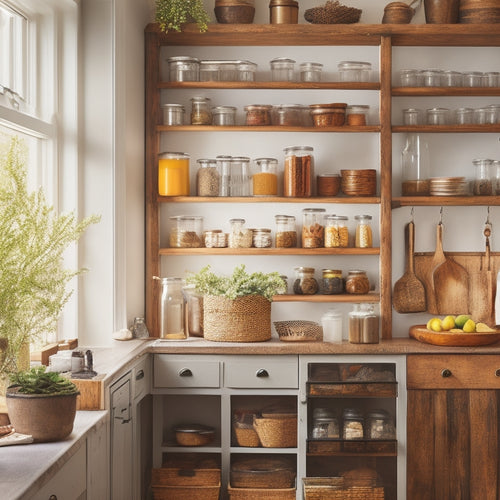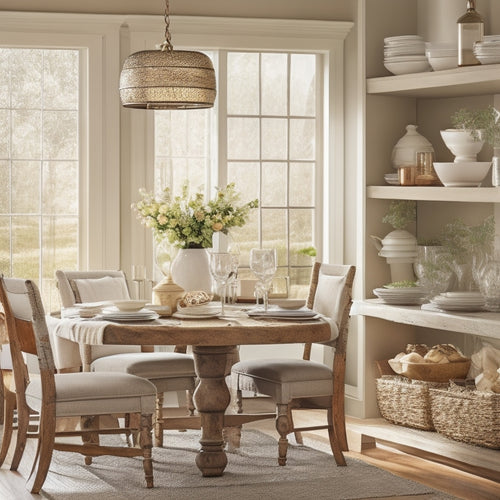
Why Pantry Organization Systems Fail (And How to Succeed)
Share
You've invested time and money into organizing your pantry, but it still doesn't function as smoothly as you'd like. You're not alone - 70% of pantry organization systems fail within the first year. Common mistakes include not purging expired items, poor labeling, and inadequate storage space. You might also be guilty of ineffective container organization, poor product grouping, and inefficient use of corner spaces. Failure to adapt to changing needs, lack of maintenance, and unrealistic expectations can also lead to failure. To get it right, take a step back, assess your needs, and plan strategically - the key to success lies in understanding what went wrong and making adjustments to create a system that truly works for you.
Key Takeaways
• Pantry organization systems fail when they lack a clear plan and strategy, leading to ineffective use of space and time.
• Overcomplicating the system and failing to declutter regularly can cause pantry organization systems to fail.
• Ignoring the importance of labeling and categorizing items can make it difficult to maintain the organization system.
• Unrealistic expectations and budgets can lead to poor pantry organization design, resulting in ineffective use of space and resources.
• Failure to adapt the pantry organization system to changing needs and neglecting regular maintenance can cause the system to fail over time.
Common Pantry Organization Mistakes
As you start on organizing your pantry, you're likely to fall into one of the most common traps that can undermine your efforts: not purging expired or unnecessary items before implementing your new system. This mistake can lead to a pantry that's cluttered and disorganized, making it difficult to find what you need when you need it.
Another common mistake is failing to create a functional labeling system. Without clear labels, you'll struggle to identify what's inside containers, leading to confusion and frustration.
Additionally, ineffective container organization can render your pantry unusable. Using containers that are too large or too small can lead to wasted space and make it difficult to access items at the back of the shelf.
To avoid these mistakes, take the time to purge your pantry of unwanted items, create a logical labeling system, and choose containers that fit your needs. By doing so, you'll set yourself up for success and create a pantry that's safe, efficient, and easy to use.
Inadequate Shelf and Storage Space
You'll likely encounter inadequate shelf and storage space if you fail to assess your pantry's dimensions and the items you need to store before selecting storage solutions. This oversight can lead to cluttered shelves, expired food, and even safety hazards.
To avoid this, take precise measurements of your pantry's width, height, and depth. Then, categorize the items you need to store, considering their size, shape, and frequency of use.
Next, invest in custom shelving that maximizes your pantry's vertical space. Adjustable racks can be particularly useful, as they allow you to modify the shelf layout as your storage needs change. Consider installing shelves with built-in baskets or bins to store small items, keeping them organized and out of the way.
Poor Product and Category Grouping
Poor product and category grouping can lead to a pantry that's challenging to navigate, causing frustration and wasted time when searching for specific items or ingredients. When you fail to group similar products together, you'll find yourself rummaging through shelves to locate what you need. This can result in expired or spoiled food, and even accidents like shattered glass or spills.
To avoid this, properly categorizing your products and grouping them logically is crucial.
Here are some tips to help you get started:
-
Group similar products together: Arrange all baking supplies, such as flour, sugar, and baking powder, on the same shelf or in the same container.
-
Utilize a labeling system: Label each shelf, basket, or container to easily identify what's inside.
-
Select the appropriate container options: Opt for airtight containers for dry goods, and baskets or bins for snacks and other items.
- Keep frequently used items front and center: Place your most-used products in accessible locations, so you won't need to search through everything to find what you need.
Inefficient Use of Corner Spaces
By maximizing the often-wasted space in pantry corners, you can create a more functional and organized storage area that complements your categorization efforts. One common mistake is to leave these areas empty or cluttered with infrequently used items.
Instead, consider installing carousel units, lazy susans, or corner shelves to make the most of this often-overlooked space. These creative solutions can help you store items like spices, oils, or specialty ingredients within easy reach.
When choosing a corner storage solution, think about the types of items you need to store and how you'll access them. For example, if you have a lot of heavy cooking utensils, a sturdy corner shelf might be a good option. On the other hand, if you have a collection of small jars or bottles, a carousel unit with adjustable tiers could be the way to go.
Failure to Adapt to Changing Needs
As your cooking habits and dietary needs evolve, your pantry organization system must adapt to accommodate these changes, lest it become outdated and inefficient.
If you don't, you'll find yourself struggling to find space for new ingredients or wasting time searching for items that no longer fit your dietary needs. A flexible solution is essential to make sure your pantry organization system remains effective.
Here are some common signs that your pantry organization system needs to adapt:
-
You've started a new diet or cooking style, and your pantry is no longer organized to support it.
-
You've added new family members or roommates, and your pantry space needs to accommodate their needs.
-
You've moved to a new home, and your pantry space is considerably larger or smaller than before.
- You've started meal prepping or cooking in bulk, and your pantry needs to accommodate the extra storage.
Lack of Maintenance and Upkeep
Neglecting to regularly clean and declutter your pantry results in an accumulation of expired or spoiled food, leading to challenges in locating necessary items and fostering an environment suitable for pests and mold proliferation. This situation may result in foodborne illnesses, unpleasant smells, and even harm to property.
To prevent this, you must prioritize routine upkeep. Dedicate time each week to organize your pantry, inspecting expiration dates and discarding any expired or spoiled goods. It's also important to seize this opportunity to clean shelves and sweep the floor to avoid the accumulation of crumbs and spills.
Furthermore, introduce clutter management strategies to deter disorder from reemerging. Allocate a specific place for each item, and ensure that everything is labeled or marked. This will enable you to swiftly identify your possessions and their locations, reducing the chances of redundant purchases and food wastage.
Unrealistic Expectations and Budgets
When you're planning your pantry organization system, you'll need to take a hard look at your space and budget constraints.
You're likely to encounter two common pitfalls: unrealistic space allocation and inadequate budget planning.
Unrealistic Space Allocation
You'll often find that unrealistic space allocation stems from a mismatch between your pantry's actual dimensions and your idealized vision of what you can fit inside it. This disparity can lead to a pantry that's cluttered, inefficient, and frustrating to use.
To avoid this, it's crucial to take a realistic approach to space allocation.
Here are some common pitfalls to watch out for:
- Failing to measure your pantry's dimensions accurately
- Not considering the size and shape of the items you need to store
- Not leaving enough space for future additions or changes
- Assuming that a single storage solution will work for all items
Inadequate Budget Planning
Setting a realistic budget for your pantry organization system is essential, as unrealistic expectations and inadequate budget planning can lead to a system that doesn't meet your needs or blows out of proportion. When you fail to plan your budget, you may end up overspending on unnecessary items or underestimating the cost of essential components. This can result in a system that's incomplete, inefficient, or even unsafe.
To avoid this, you need to assess your shopping habits and identify areas where you can cut costs without compromising the functionality of your pantry organization system. Consider your time management skills as well, as a poorly planned system can waste your time and energy.
Allocate your budget wisely, prioritizing essential components such as shelving, storage containers, and labels. Be realistic about what you can afford and avoid impulse purchases. By setting a realistic budget and sticking to it, you can create a pantry organization system that meets your needs, saves you time, and provides a safe and efficient storage space for your food and kitchen essentials.
Frequently Asked Questions
How Do I Decide Which Pantry Organization System Is Best for My Space?
As you start on a journey to tame your pantry chaos, you're faced with a vital decision: which organization system is the perfect fit for your space? Consider space utilization, budget considerations, aesthetic appeal, and functionality to craft a harmonious blend that meets your unique needs.
Can I DIY a Pantry Organization System or Do I Need a Professional?
You can DIY a pantry organization system, but weigh the pros and cons: your time and effort vs. a professional's expertise. Budget-friendly DIY options include adjustable shelves, baskets, and labels, but consider your safety and ability to execute the project.
How Often Should I Clean and Reorganize My Pantry to Maintain It?
You should clean and reorganize your pantry every 1-3 months to maintain it. Set reminders to guarantee consistent maintenance, and use tips and tricks like categorizing, labeling, and purging expired items to make the task more efficient.
Are Custom Pantry Organization Systems More Effective Than Pre-Made Ones?
You'll find that custom pantry organization systems offer tailored solutions, but come with a higher price tag, whereas pre-made ones are budget-friendly, yet may not fit your space perfectly, so weigh the pros and cons before deciding.
Can a Pantry Organization System Be Adapted for a Pantry With Sloping Ceilings?
You're likely among the 70% of homeowners dealing with unique pantry spaces; adapting to sloping ceilings requires creative solutions for best space utilization, such as custom shelving and hanging baskets to maximize storage.
Related Posts
-

Rust-Resistant Dish Drainers for Long-Lasting Use
If you're looking for rust-resistant dish drainers, focus on materials like high-grade stainless steel for superior c...
-

Creative Organization Ideas for Tight Kitchen Spaces
To create an organized kitchen in tight spaces, think upwards. Install shelves that reach the ceiling and use wall-mo...
-

Corner Cabinet Storage for Dinnerware Sets
Corner cabinet storage for dinnerware sets can change your kitchen into an organized, stylish space. By utilizing ver...


